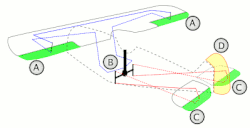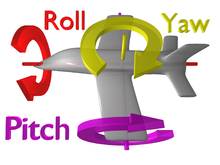Flight control surfaces

Aircraft flight control surfaces are
Development of an effective set of flight control surfaces was a critical advance in the development of aircraft. Early efforts at fixed-wing aircraft design succeeded in generating sufficient lift to get the aircraft off the ground, but once aloft, the aircraft proved uncontrollable, often with disastrous results. The development of effective flight controls is what allowed stable flight.
This article describes the control surfaces used on a fixed-wing aircraft of conventional design. Other fixed-wing aircraft configurations may use different control surfaces but the basic principles remain. The controls (stick and rudder) for rotary wing aircraft (helicopter or autogyro) accomplish the same motions about the three axes of rotation, but manipulate the rotating flight controls (main rotor disk and tail rotor disk) in a completely different manner.
Flight control surfaces are operated by aircraft flight control systems.
Considered as a generalized fluid control surface, rudders, in particular, are shared between aircraft and watercraft.
Development
The
Axes of motion


An aircraft is free to rotate around three axes that are perpendicular to each other and intersect at its
Transverse axis
The transverse axis, also known as lateral axis,[3] passes through an aircraft from wingtip to wingtip. Rotation about this axis is called pitch. Pitch changes the vertical direction that the aircraft's nose is pointing. The elevators are the primary control surfaces for pitch.
Longitudinal axis
The longitudinal axis passes through the aircraft from nose to tail. Rotation about this axis is called roll.
Vertical axis
The vertical axis passes through an aircraft from top to bottom. Rotation about this axis is called yaw.[3] Yaw changes the direction the aircraft's nose is pointing, left or right. The primary control of yaw is with the rudder. Ailerons also have a secondary effect on yaw.
It is important to note that these axes move with the aircraft, and change relative to the earth as the aircraft moves. For example, for an aircraft whose left wing is pointing straight down, its "vertical" axis is parallel with the ground, while its "transverse" axis is perpendicular to the ground.
Main control surfaces
The main control surfaces of a fixed-wing aircraft are attached to the airframe on hinges or tracks so they may move and thus deflect the air stream passing over them. This redirection of the air stream generates an unbalanced force to rotate the plane about the associated axis.

Ailerons

Elevator
The
In the canard arrangement, the elevators are hinged to the rear of a foreplane and move in the opposite sense, for example when the pilot pulls the stick back the elevators go down to increase the lift at the front and lift the nose up.
Rudder
The rudder is typically mounted on the trailing edge of the vertical stabilizer, part of the empennage. When the pilot pushes the left pedal, the rudder deflects left. Pushing the right pedal causes the rudder to deflect right. Deflecting the rudder right pushes the tail left and causes the nose to yaw to the right. Centering the rudder pedals returns the rudder to neutral and stops the yaw.
Secondary effects of controls
Ailerons
The ailerons primarily control roll. Whenever lift is increased,
Rudder
The rudder is a fundamental control surface which is typically controlled by pedals rather than at the stick. It is the primary means of controlling yaw—the rotation of an airplane about its vertical axis. The rudder may also be called upon to counter-act the adverse yaw produced by the roll-control surfaces.
If rudder is continuously applied in level flight the aircraft will yaw initially in the direction of the applied rudder – the primary effect of rudder. After a few seconds the aircraft will tend to bank in the direction of yaw. This arises initially from the increased speed of the wing opposite to the direction of yaw and the reduced speed of the other wing. The faster wing generates more lift and so rises, while the other wing tends to go down because of generating less lift. Continued application of rudder sustains rolling tendency because the aircraft flying at an angle to the airflow - skidding towards the forward wing. When applying right rudder in an aircraft with
Turning the aircraft
Unlike turning a boat, changing the direction of an aircraft normally must be done with the ailerons rather than the rudder. The rudder turns (yaws) the aircraft but has little effect on its direction of travel. With aircraft, the change in direction is caused by the horizontal component of lift, acting on the wings. The pilot tilts the lift force, which is perpendicular to the wings, in the direction of the intended turn by rolling the aircraft into the turn. As the bank angle is increased, the lifting force can be split into two components: one acting vertically and one acting horizontally.
If the total lift is kept constant, the vertical component of lift will decrease. As the weight of the aircraft is unchanged, this would result in the aircraft descending if not countered. To maintain level flight requires increased positive (up) elevator to increase the angle of attack, increase the total lift generated and keep the vertical component of lift equal with the weight of the aircraft. This cannot continue indefinitely. The total
Alternate main control surfaces
Some aircraft configurations have non-standard primary controls. For example, instead of elevators at the back of the stabilizers, the entire tailplane may change angle. Some aircraft have a tail in the shape of a V, and the moving parts at the back of those combine the functions of elevators and rudder. Delta wing aircraft may have "elevons" at the back of the wing, which combine the functions of elevators and ailerons.
Secondary control surfaces

Spoilers
On low drag aircraft such as
Flaps
Slats
Air brakes

Air brakes are used to increase drag. Spoilers might act as air brakes, but are not pure air brakes as they also function as lift-dumpers or in some cases as roll control surfaces. Air brakes are usually surfaces that deflect outwards from the fuselage (in most cases symmetrically on opposing sides) into the airstream in order to increase form-drag. As they are in most cases located elsewhere on the aircraft, they do not directly affect the lift generated by the wing. Their purpose is to slow down the aircraft. They are particularly useful when a high rate of descent is required. They are common on high performance military aircraft as well as civilian aircraft, especially those lacking reverse thrust capability.
Control trimming surfaces
Trimming controls allow a pilot to balance the lift and drag being produced by the wings and control surfaces over a wide range of load and airspeed. This reduces the effort required to adjust or maintain a desired flight
Elevator trim
Elevator trim balances the control force necessary to maintain the correct aerodynamic force on the tail to balance the aircraft. Whilst carrying out certain flight exercises, a lot of trim could be required to maintain the desired angle of attack. This mainly applies to slow flight, where a nose-up attitude is required, in turn requiring a lot of trim causing the tailplane to exert a strong downforce. Elevator trim is correlated with the speed of the airflow over the tail, thus airspeed changes to the aircraft require re-trimming. An important design parameter for aircraft is the stability of the aircraft when trimmed for level flight. Any disturbances such as gusts or turbulence will be damped over a short period of time and the aircraft will return to its level flight trimmed airspeed.
Trimming tail plane
Except for very light aircraft, trim tabs on the elevators are unable to provide the force and range of motion desired. To provide the appropriate trim force the entire horizontal tail plane is made adjustable in pitch. This allows the pilot to select exactly the right amount of positive or negative lift from the tail plane while reducing drag from the elevators.
Control horn

A control horn is a section of control surface which projects ahead of the pivot point. It generates a force which tends to increase the surface's deflection thus reducing the control pressure experienced by the pilot. Control horns may also incorporate a counterweight which helps to balance the control and prevent it from fluttering in the airstream. Some designs feature separate anti-flutter weights.
(In radio controlled model aircraft, the term "control horn" has a different meaning)[6][7]
Spring trim
In the simplest arrangement, trimming is done by a mechanical spring (or bungee) which adds appropriate force to augment the pilot's control input. The spring is usually connected to an elevator trim lever to allow the pilot to set the spring force applied.
Rudder and aileron trim
Most fixed-wing aircraft have a trimming control surface on the
See also
- Aircraft engine controls
- Aircraft flight control systems
- Aircraft flight mechanics
- Flight with disabled controls
- Ship motions
- Six degrees of freedom
- V-tail
- Wing warping
Notes
- ^ Patents
- U.S. patent 821,393 — Flying machine — O. & W. Wright
- U.S. Patent 821,393—for those who do not have USPTO graphics plugin
- ^ *Centennial of flight Archived 2008-05-05 at the Wayback Machine - illustration of Wilbur Wright invention of wing warping using a cardboard box
- ^ a b c "MISB Standard 0601" (PDF). Motion Imagery Standards Board (MISB). Archived from the original (PDF) on 24 March 2017. Retrieved 1 May 2015. Also at File:MISB Standard 0601.pdf.
- ^ Clancy, L.J. Aerodynamics, Section 16.6
- ^ Clancy, L.J. Aerodynamics Chapter 6
- ^ ""Servo Control"". Archived from the original on 2017-09-16. Retrieved 2012-10-23.
- ^ Model Aircraft: control horn FAQ Archived 2013-05-13 at the Wayback Machine
References
- Private Pilot Manual; Jeppesen Sanderson; ISBN 0-88487-238-6(hardcover, 1999)
- Airplane Flying Handbook; U.S. Department of Transportation, Federal Aviation Administration, FAA-8083-3A. (2004)
- ISBN 0-273-01120-0
External links
- A clear explanation of model aircraft flight controls by BMFA Archived 2017-02-08 at the Wayback Machine
- See How It Flies By John S. Denker. A new spin on the perceptions, procedures, and principles of flight.
